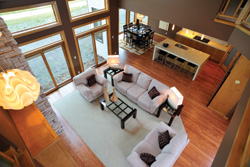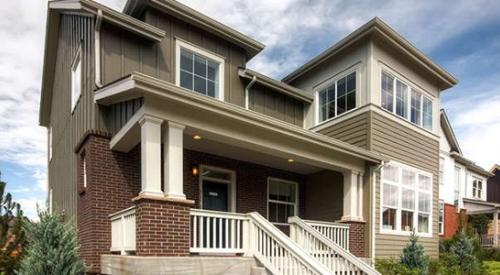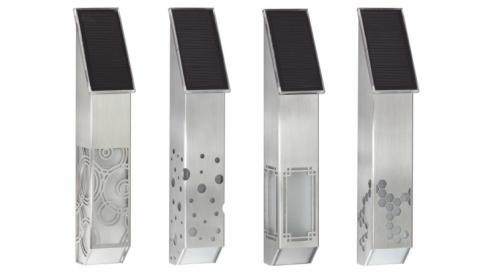If there's one positive to come out of this devastating economic slump it's the advancement of the green, high-performance building movement in the U.S. housing market. Once thought of as a niche product fit only for deep-pocketed environmental enthusiasts, green homes are making their way into the mainstream housing market, driven largely by builders who are looking for a leg up on the competition.
Meritage Homes, Lennar and Beazer Homes are among the large production builders to recently launch comprehensive green, energy-efficient housing programs. Meritage, for instance, is providing an Energy Star rating as standard for no additional cost for all new homes it builds.
"In five years, green is going to be a staple - something that has to be in all new homes," says Megan Messer, marketing director with Fargo, N.D.-based builder Heritage Homes, which launched its HomeCare green homes program earlier this year. "That's the direction consumers and the industry are going."
But marketing and selling green brings a whole new set of challenges for home builders, especially when it comes to educating consumers and cutting through the clutter of information - and misinformation - about sustainability, energy efficiency and green. We asked several experts for their advice on marketing and selling green, high-performance homes. They offer the following tips:
1. Do the math for buyers
Any time builders can talk about putting money back in the pockets of consumers they have a strong sales proposition, says Alan Gremillion, senior purchasing agent with Minto Communities, Coconut Creek, Fla., which recently launched its Minto Blue green homes program. "In today's economy, cost savings is by far the number-one feature when selling green," he says.
If your high-performance homes save homeowners money in monthly utility costs, play it up during the selling process by "doing the math" for potential buyers. For example, Norman, Okla.-based Ideal Homes is among a number of green home builders that provides potential buyers with a side-by-side cost comparison of their line of energy-efficient homes versus a typical area home.
"When presenting our product as energy efficient, we ask people, "Is saving money something that's important to you?" Not to bait them, but we can walk them back through and make logic out of it," says Brian Bergerson, division manager of sales for Ideal Homes. "The sticker price may be a little higher, but it's going to cost less to live in our homes. When we present this option, there's usually at least one in a couple that thinks it makes sense, whether it's the husband or wife."
Rather than showing straight dollar amounts in comparisons, use colorful charts and graphs, says Roland Nairnsey, vice president of training and development with Bob Schultz & The New Home Sales Specialists, Boca Raton, Fla. "You really want to play up the cost difference. Charts are much more dramatic than showing straight dollar comparisons," says Nairnsey.
In addition, make sure your comparison numbers are pinpoint accurate, especially when offering a guarantee on utility savings. "I have yet to see a builder who can do the math part successfully, unless they're paying a third-party, such as EnergyWise, to help them with that guarantee portion," says Steve Bertasso, senior associate with TrueNorth DevelopÂment, Northville, Mich.
"Whenever you put math in front of a consumer, I don't care how many disclaimers you put on top of it, it can lead to problems - disclaimers don't fix customer satisfaction," says Bertasso. "All you need is that one consumer who has to have the house at 76 degrees in the winter and 68 in the summer, and they're going to ask why their energy bills are so much higher than what you told them they were going to be."
For builders that want to use cost comparisons but don't want to pay for a third-party guarantee, Bertasso says to pad the advertised numbers. "If you know your homes are 50 percent more efficient, then advertise that you're going to be 10 to 15 percent better."
2. Avoid talking payback periods
When pitching green and energy-efficiency packages, many builders focus on the payback period for the systems and features - a big mistake, says Charlie Scott, partner with Woodland, O'Brien & Scott, St. Paul, Minn.
"If the initial investment is $3,500 for an upgraded heating/cooling system that's going to save the homeowner $30 a month, think how long it will take them to earn back that money," says Scott.
Instead, frame the discussion in terms of ongoing, monthly savings, using today's low interest rates and high utility rates to your advantage. "At the current interest rates, $3,500 equates to something like a $20 a month house payment. So if that system saves $30 in utilities each month, the homeowner is cash flow positive right off the bat."
Bertasso adds that if builders insist on talking payback during the sales presentation, make sure the period is less than three years. "Even in this economy, the majority of buyers think they'll be out of that house in three to five years. A six- or seven-year payback does not mean anything to them."
3. Cater your message to the green buyer type
Because green means different things to different people, builders have to be able to quickly identify what's truly important to the individual buyer.
"There are so many different levels of interest in green that it's important when a customer walks in the door all their needs are met, whether they just want green products or want to create a healthy home for their family," says Heritage Homes' Messer.
For instance, when developing Heritage's HomeCare program, Messer and company CEO Daryl Braham identified four primary buyer types - all female (because of their purchasing influence):
- "Elise" - Her home is her haven. Traits: traditional, practical, family-orientated, predictable
- "Margo" - Her home is unique. Traits: contemporary, edgy, goal-oriented, individualistic
- "Claire" - Her home makes a statement. Traits: formal, sophisticated, quality-driven, detail-oriented.
Based on the personality type the consumer chooses as best describing her, the salesperson crafts the presentation to meet her needs. "For example, an 'Elise' home buyer is really concerned about her family's needs, so she wants to learn about what we're doing as a builder to make her home healthy and safe," says Messer. 'Margo',on the other hand, is going to be most apt to latch on to products like cork flooring and recycled glass countertops - features that are unique."
4. Overcome key objections to green
Handling objections is a way of life for new-home sales professionals, and selling green only adds to the deluge of questions, especially when higher first costs are involved. Nairnsey says sales professionals can avoid most objections by being proactive at explaining and demonstrating the benefits throughout the entire sales process. "When done right, most objections will be addressed during the builder story presentation, model home demonstration and at the closing table," says Nairnsey.
Still, invariably, objections will come up, and sale professionals need to be prepared to manage the tough questions. Nairnsey teaches a six-step formula for overcoming virtually any objection in the new-home sales process:
1. Listen - be empathetic, not sympathetic. Simply say, "I hear you."
2. Reflect and minimize - repeat the question back and attempt to minimize.
3. Question the objection - Compliment the question and preface your questions with, "Please help me understand." Always use open-ended questions: how, what, when, where, who, tell me more, please share with me, etc.
4. Answer - Respond with your best, preplanned answer based upon their reason for asking. Typically, your response will include either a third-party testimonial statement or research statement, or both.
5. Confirm - Make sure that you have answered it correctly by following up with something like, "How does that sound?" or "Do you feel more comfortable now?"
6. Move on - Don't sell past the close.
5. Don't forget about the health benefits
Consider that kids spend as much as 90 percent of their time indoors and that indoor air quality is often worse than outside, and there's no wonder why many home buyers rank health and safety benefits as top considerations when shopping for a new home. The challenge for builders is making the connection for consumers.
"A lot of consumers just don't think about the health benefits when talking green," says Minto's Gremillion. "When we explain that we're building healthier homes for people to live in, it's something that definitely resonates with buyers."
Nairnsey says improved indoor air quality is only a benefit if your sales team knows how to sell it. "For example, if you use low-VOC paint, train the sales staff to tap the wall during the demonstration, explain the benefits of that feature and ask something like, 'Would having healthy air be important to you and your family?' Who's ever going to say no to that," he says. PB













